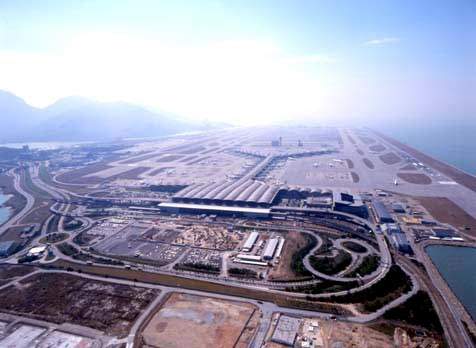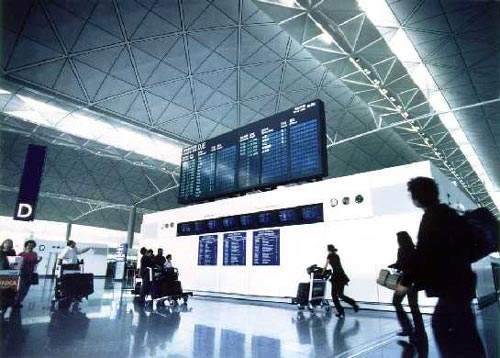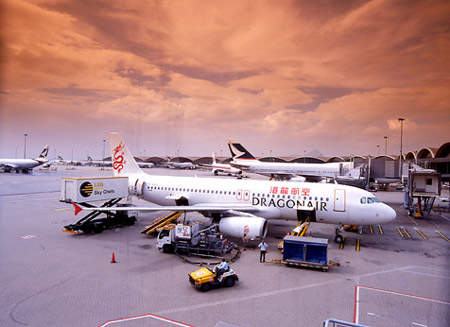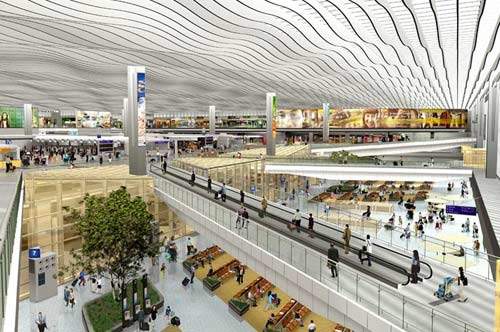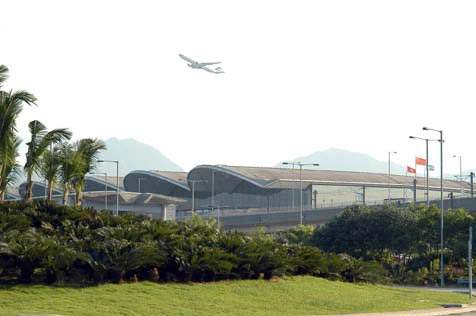The construction of Hong Kong International Airport at Chek Lap Kok was one of the biggest operations in the industry. The core programme cost more than $20bn and involved four major sponsors, ten separate projects, 225 construction contracts and over 1,000 critical interfaces.
The airport covers 12.48km² of reclaimed land between the two islands of Chek Lap Kok and Lam Chau. The airport increased the land area of Hong Kong by 1%. The airport opened for business in July 1998, having taken just six years to build.
There are two parallel runways (3,800m×60m). One is category II and the other is the higher category IIIA allowing landing in only 200m visibility. A third runway has been considered but this is still very much in the planning stage. In January 2008, to increase operational efficiency the airport introduced RFID (radio frequency identification) baggage tags to the airport check-in procedure.
The new tags printed out to tag passenger luggage contain an embedded RFID chip along with a barcode. The tags can be read from a distance and with an efficiency of around 97% compared to 80% for barcode-only tags and are now being issued in terminals one and two and in Kowloon Station to about 40,000 bags a day for 50 airlines. RFID luggage handling has been approved by the IATA (International Air Transport Association).
Hong Kong Airport facilities
Hong Kong International Airport is the fourth busiest in the world; it has seen an average of 750 aircraft take-offs and landings every day and carried over 48.6 million passengers in 2006. The cargo areas are some of the world’s busiest and handled over 3.6 million tonnes in 2006.
The shopping and leisure facilities include the airport’s SkyMart with 160 shopping outlets and 40 restaurants spread over 39,000m². The facilities also include free and pay internet lounges, Wi-Fi access, many lounges and TV screens and a children’s play area. The superior facilities have meant that the airport has been voted the world’s best in 2002, 2003, 2004 and 2005 (came first in Skytrax’s world airport awards in 2007) and is consistently in the top-five list.
The strategic location of HKIA makes it the preferred choice of global businesses; it links Hong Kong with more than 150 destinations, including 40 cities on the Chinese mainland.
The elaborate and meticulously planned multi-modal transport network ensures the smooth flow of movement between HKIA and the Chinese mainland. More than 90 PRD cities and towns are linked with HKIA by nearly 320 coach trips. Speedy cross-boundary arrangements are offered at Shenzhen Shekou and Fuyong, Dongguan, Zhongshan, Zhuhai and Macau. At places like Fuyong, Shekou, Macau and Dongguan Humen passengers can even pre-check their baggage and obtain their boarding pass.
Skytrax, an independent air transport research organisation, has ranked HKIA the top airport for eight consecutive years. The 60,000-strong airport community ensures the highest standards of aviation excellence and preserves Hong Kong’s precedence as the leading regional and international aviation hub.
HKIA access
A new transportation corridor stretches 34km from Hong Kong Island to the site of the airport, incorporating a high-speed rail system, two tunnels, two bridges and a six-lane expressway.
The SkyPier cross-boundary ferry service provides connectivity between the Pearl River Delta (PRD) region and international destinations through the HKIA. Passengers using the ferry service need not go through Hong Kong immigration and customs formalities.
Designed for the rapid movement of millions of passengers, the airport has 288 check-in counters, 200 immigration desks and 80 customs positions. The new airport also boasts 2.5km of moving walkways and around 120 shops.
Negotiations between the Chinese government, the Chek Lap Kok government and (until the handover of the colony in 1997) the British government were complex. However, the main difficulties were resolved by the mid-1990s.
Sky City
The airport complex grew with the construction of a new development adjacent to the passenger terminal called Sky City. This consists of Sky Plaza, an office, retail and business complex integrated with the passenger terminal (terminal two), which then links to the rest of Sky City.
Sky City has the Asia-World Expo exhibition centre, a second hotel project (Marriot Hotel Sky City opened in December 2008), a nine-hole golf course and a permanent cross-boundary ferry terminal (Sky Pier). Phase two may well consist of a business park, more hotels, and further leisure and entertainment facilities.
The Sky City complex is expected to gain much business from the opening of the Disney theme park (opened in September 2006) as will the airport itself. Skidmore, Owings and Merrill is the architect, planner and engineer for the Sky City project.
The Sky Plaza was opened in February 2007 and included the second terminal of the airport and a new airport express platform, which serves the new terminal (Sky Plaza and Terminal 2 have a floor area of 140,000m²). The shopping mall opened, as well providing a variety of shops, restaurants and entertainments for passengers.
The project also involved the expansion of the east hall of terminal one to provide integration with the overall airport complex (Terminal 1 has a floor area of 570,000m²).
The airport has also added extra inter-modal transportation facilities, including the new marine terminal (hosting the cross-boundary and domestic ferries), an additional airport express line (new platform opened for T2), which will be adjacent to the exhibition centre and a new coach station (this was opened in Terminal 2 in February 2007).
Sky Plaza, which extends from the passenger terminal and is fully integrated with the airport and airport express railway station features airline check-in facilities, a transport interchange for coaches (in readiness for Disney), two office towers (total of 30,000m²) and a 38,000m² retail and entertainment centre. Sky Plaza (T2) is only used for departures of passengers.
Sky Plaza cost an estimated HK$2bn to complete. The contract for the construction was awarded to Chun Wo-Fujita joint venture. A new land transport terminal is situated in Sky Plaza providing improved services for cross-boundary coach passengers (36 bay coach station allowing 240 trips a day across the border). This includes customs, immigration, quarantine and security screening facilities.
A three-station people-mover system connects Sky Plaza to the existing passenger terminal (a contract for this was awarded to Ishikawajima-Harima Heavy Industries). The driverless APM (automated people mover) system runs at 62km/h and there is a train every 1.5 minutes to provide transport from check-in to the gate areas.
A contract for extending the people-mover tunnel to allow for a future direct connection between Sky Plaza and the airport’s ferry terminal was also awarded to the Chun Wo–Fujita joint venture.
Cargo expansion
DHL opened a new Central Asia Hub in August 2004, a dedicated and purpose-built air express cargo facility, at the Hong Kong International Airport. The $100m facility is the largest of its kind in the region. With the opening of the new Central Asia Hub, DHL became the only express and logistics company to operate a dedicated air express cargo facility in Hong Kong. The 18,200ft² facility is capable of handling up to 440t a day of air express cargo.
Another important cargo development was the expansion of the Asia Airfreight Terminal, which was announced in 2004. Asia Airfreight invested HK$1.75bn in the construction of a new terminal (completed by the end of 2006). The terminal has a handling capacity of 910,000t a year, which triples its current capacity.
Air cargo in Hong Kong has been growing at 6% a year and express cargo at 13% a year. The new facility means that Asia Airfreight can meet long-term cargo capacity demands.
In March 2008 the board of the Airport Authority of Hong Kong awarded a 20-year franchise to design, construct and operate a new 246,000m² cargo terminal at the airport to Cathay Pacific Services Limited.
Construction of the new cargo terminal began in 2008. It was initially scheduled to open in the second half of 2011, but the completion has been deferred to mid-2013 as per Cathay’s proposal. An announcement to this end was made by the board of the Hong Kong Airport Authority in January 2009.
The facility will have an annual capacity of around 2.6 million tons and will increase the airport’s total general cargo handling capacity to 7.4 million tons per annum. The new facility is being constructed on a 10ha site in the cargo terminal area and when open will employ 1,700 personnel. The number of general and express cargo operators at HKIA will then increase from three to four. Cathay Pacific’s investment in the new facility will be of the order of HK$4.8bn.
The cargo terminal will provide an exceptionally high land-use efficiency of over 25t/m² and will be equipped with a state-of-the-art materials handling system (MHS) to handle the massive throughput.
Contracts
The 1.3km-long passenger terminal was engineered and designed by Arup (UK). Their brief included providing concept-engineering / design and detailed design for the architectural steelwork and fire and acoustic engineering. The $1.29bn passenger terminal construction contract was awarded in the first quarter of 1995 to a consortium comprising the China State Construction Engineering Corporation, Kumagai Gumi, Maeda Corporation, Amec, International Construction and Balfour Beatty. Construction began in January 1995.
The passenger terminal contract included sub-contracting work to fit the terminal with lifts, escalators, walkways, aircraft loading bridges and air-conditioning facilities. The subcontract for building services within the terminal (worth about $241m) was awarded to a joint venture of Hsin Chong Aster Building Services of Hong Kong, Aster Associate Termoimplanti of Italy and Ellis Mechanical Services of the UK.
Subcontractors
Two subcontracts were awarded by Hong Kong’s Provisional Airport Authority (PAA). One, worth HK$96.58m, was given to Ryoden Lift and Escalator Co Ltd of Hong Kong. The other, worth HK$107.96m, was awarded to CNIM of France. A further HK$87m subcontract to build the toll plaza for the Lantau fixed crossing was awarded to Yau Lee Construction Co Ltd, a wholly-owned construction unit of Yau Lee Holdings Ltd.
Lindner KG of Arnstorf was awarded a contract in April 1995 for the HK$31m supply and erection of 160,000m² of metal roofing for the terminal. Paul Y was awarded a HK$467.4m contract for the construction of roads and drainage works related to the airport in April 1995. Wenco constructed the airport’s aviation fuel piping system for servicing 70 aircraft bays.
ICL, part of Fujitsu, won a contract worth HK$16.3m to supply an integrated voice and data communications infrastructure. This was awarded in June 1995, with installation beginning in June 1996 and completed in June 1997.
The Downer-Paul Y-McAlpine joint venture awarded an HK$21m airfield ground lighting subcontract to Thorn Europhane.
SigNet was awarded the contract for the public address system and DG Edgworthy were consultants for the contract providing documentation and training materials.
HKIA enhancements
HKIA has been one of the largest engineering and architectural projects in the world. The airport was realised with a total investment of HK$50bn. Recent extensions at the airport include the building of the second terminal, ten new cargo stands, HKIA Tower and the Airport World Trade Centre.
To guarantee HKIA’s long-term competitiveness an HK$4.5bn enhancement programme has been brought into place. This includes extending the capacity of the first terminal, airfield improvements such as the building of the north satellite concourse, reconfiguring the departures immigration hall, adding new taxiways and resurfacing the two runways.
The new air cargo terminal under construction will create better aviation support services and more efficient air cargo handling facilities. The additional hangers being built will ensure quality aircraft and business jet maintenance. The burgeoning air traffic created the need for building a third runway at the airport, for which engineering and environmental feasibility studies are now being carried out.
A new ferry route has been opened between the airport and Nansha Port in Guangzhou. The new route improves connectivity between HKIA and Pearl River Delta (PRD).
The airport is investing around HK$90m to add new automated people mover (APM) cars. A total of eight such cars will supplement the existing fleet of 20. By the end of 2009, the new cars will provide better connectivity between the permanent SkyPier, Terminal 1 and Terminal 2, and enhance airport transportation to meet the future demand.
Motorola has completed the installation of TETRA (terrestrial trunked radio) digital radio communication system at HKIA in February 2009. The airport authority awarded the contract to replace the existing analogue system with TETRA to Motorola in February 2008.
Eight dispatch consoles and three IP base station sites were installed. These provide coverage all over the airport. The new system provides uninterrupted radio communications between the user groups involved in security, baggage, maintenance and other ground handling services.

